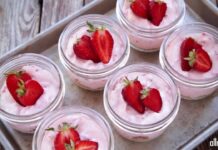December is the time for baking in the kitchen, insulated against the cold weather by a festive fug of spices, brandy and rich dried fruit: cookies, mince pies, Christmas pudding, Christmas cake. The Christmas cake should be prepared well ahead of time so it has time to develop moistness and flavour. Usually I procrastinate and bake it only a week before Christmas but this year I was determined to do it right. So yesterday the kitchen exuded a gentle spicy aroma as the cake cooked extremely slowly for four and a half hours. Just one whiff is enough to conjure up Christmas.
It is just the sort of rich, damp, heavy fruit cake that Captain Hook put out to poison the Lost Boys in the original Peter Pan story. That detail seems to have been omitted in the updated versions, maybe these days it seems too old-fashioned to believe that rich cake is death to young stomachs! My kids aren’t really into the cake itself anyway, but they love the marzipan and icing, so will nibble meagrely at the cake in order to justify feasting on their icing and that of the adults as well, who Jack Sprat-like tend to prefer the cake and leave the excess sweet icing to the children.
Just before Christmas I usually get out the reliable old Delia Smith cook book to check out the cake recipe and quantities for the marzipan. Her recipes almost always work and are accurate if not always inspired. Now she is long supplanted by the younger, sexier Nigella, but her books are still at the back of my shelf for when I need to check details of some ordinary but useful dish.
Rich Fruit Cake Recipe
175g/6oz sultanas
50g/2oz glace cherries(optional)
50g/2oz mixed candied peel chopped
½ teaspoon salt
¼ teaspoon grated nutmeg
½ teaspoon mixed spice
225g/8oz unsalted butter
225g/8oz soft brown sugar
4 large eggs
50g/2oz chopped almonds
grated rind of 1 orange
Leave it in a covered bowl over night or at least twelve hours.
Grease and line a 20cm/8 inch round cake tin or a 18cm/ 7 inch square one.
Sift together the flour, salt and spices. Cream the butter and sugar together in a large mixing bowl until light and fluffy (make sure you do this thoroughly). Beat eggs and add them a little at a time to the creamed mixture, beating well each time. Spoon the mixture into the prepared cake tin and spread it out evenly. Tie a band of brown paper round the outside of the tin and cover the top of the cake with a double layer of greaseproof paper (with a hole cut in the middle of it) Bake the cake at 140C/275F on the lower shelf of the oven for 4 ¼ – 4 ¾ hours. Don’t open the door to check until at least 4 hours have passed. Once the cake has cooled wrap it in a layer of greaseproof paper then foil.
Our cake is now well wrapped in grease-proof paper and foil and stored on a shelf in the larder to steep in its own flavours. A week before Christmas I’ll make the marzipan to go on it. I’ll have a lot of help with that as the children vie to gather up any scraps that fall or are trimmed off. We’ve even converted marzipan haters in the family to our variety of almond paste, just by leaving out the almond essence, which gives the strong almost metallic taste to shop marzipan.
When I was growing up we had a set of figures for a Nativity scene that always decorated the cake and it was my favourite job to arrange them with a few tiny pine trees for added effect. You can be creative with your decoration, go for elegant with a single artificial poinsettia flower or fun with plastic animals – a donkey and ox, or as I often do being in Africa, a zebra, elephant and giraffe – standing around in the snow. Silver balls could make a star or you could find a tiny angel decoration to stand atop the cake heralding Christmas.
Over the years it has been given many names, which can be confusing when buying. In Australia it is known as Plastic Icing. The term plastic is a good description – according to the dictionary it means supple and pliable, exactly how it is.
Liquid glucose will keep the paste pliable and gelatine allows it to stretch. Sugarpaste has many uses. It can be used for modelling figures, flowers and leaves. Also by softening it with a few drops of water, or egg white, it can be piped. So as you can see it is a very versatile icing.
However, its main use is still as a coating for cakes. But like everything else, it is easy when you know how, so here are a few tips to prevent anything going wrong.
If a flat top is needed, and the cake is rounded, cut this off, and upturn the cake so the base now becomes the top surface.
Make sure the coating goes right down to the bottom of the cake. Sprinkle icing sugar (not cornflour, as this dries the sugarpaste and could make it crack) on the working surface. Now roll out the paste – if possible, using a long rolling pin, as a short one could leave marks. Roll until the paste is approximately ¼” thick.
To apply the paste, position the cake as close to you as possible, carefully lift the paste, either on the rolling pin, or on the back of the hands, and lay over the cake surface. Then, using the palm of your hand, gently smooth the paste onto the sides of the cake with an upward movement. If any air bubbles appear on the surface of the paste, prick them with a sterilised pin.
A simple and effective decoration is to crimp the top edge of the cake – within 15 minutes of applying the paste. Then stick a thin roll of paste around the base of the cake and also mark this with a crimper. Now all you need is some sort of made (or bought) decoration for the top. Good luck!!
It can be difficult to choose what medium to decorate with. Moreover, let’s face it – fondant is not for beginners. When it comes to cake decorating, icing is used to make many decorations from flowers to specialty designs or borders. Just icing the cake is an issue for many novices. What you need to do is go talk with others and get their advice, tips and tricks too.
Cookbooks, kits and a monthly email newsletter are not going to help you much. Just try and imagine one site, one community that has literally everything you need. You can go and get your ideas, then you can watch a video and learn or enhance a skill, then you can talk with others along the way, or email for support and answers. You won’t need another resource of any kind, jut a lot of time to practice cake decorating; icing included.
I know you’re probably like me and have to see for yourself and seeing is believing when it comes to cake decorating. I encourage you to do yourself a favor and invest one time in one resource.
When I was growing up as a small child, I always looked forward to the homemade chocolate cakes that my grandmother would make for my Birthday. In our family, my grandmother was a dedicated baker and would bake something for us every day. Thankfully, she passed on her love for baking to me.
This recipe is done the old-fashioned way and is topped off with some delicious chocolate icing. Once your cake is cooled, you will want to store it in a cake container.
1/2 pound butter, softened
5 eggs
2 cups granulated sugar
3 cups all-purpose flour
3 teaspoons baking powder
1/2 teaspoon salt
1/2 cup milk
2 teaspoons vanilla extract
1/4 cup evaporated canned milk
Preheat oven to 350 degrees.
In a large mixing bowl, cream together the softened butter and granulated sugar. Slowly add in the eggs, one at a time, beating after each addition.
In a medium-sized mixing bowl, combine the all-purpose flour, baking powder and salt. Slowly add 1/2 of the flour mixture to the wet ingredients and beat for 1 minute. Pour in the 1/2 cup of milk and beat again, followed by the remaining flour mixture. Stir in the vanilla extract and beat again. Finally, stir in the 1/4 cup of evaporated milk and beat until all ingredients are well combined.
Lightly spray a 9 x 13″ baking dish with nonstick cooking spray. Pour the batter into the pan. Bake in a 350 degree oven for 35 to 45 minutes or until cake is done in the center. Cool cake on a wire rack.
Chocolate Icing Ingredients:
2 1/2 squares baking chocolate
2 cups granulated sugar
1/2 cup evaporated milk
In a large saucepan, melt the baking chocolate over low heat. Stir in the granulated sugar and evaporated milk. Bring to a boil and boil for 2 to 3 minutes or until a soft ball forms when dropped into cold water. Remove pan from heat and stir in the butter and vanilla extract. Beat icing by hand until it is thick enough to spread on your cooled cake.








































